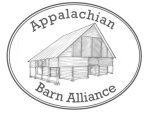The Walnut township is a large, long township divided by the French Broad River. Its historic barns quietly tell the lifestyle stories of the farm families who settled here over the past two hundred years. On the west side of the river, the Big Pine Creek valley is generally steep and narrow, and the visitor will be struck by its remoteness and lack of tillable land, a testament to the resourcefulness of its farmers. The known history of these older barns is limited, as they have survived with few family descendants remaining to tell their stories. Many barns are referred to by a historic owner’s name, yet that barn’s history and ownership may be several generations removed. In general, the barns were built by the farmer with the help of neighbors, one or more carpenters, and were often influenced by “new” barn designs seen elsewhere.
While very few barns of the 1800’s have survived, an important exception is the now rare, flue-cured tobacco log barn. Mountain subsistence farming changed dramatically when flue-cured or “bright leaf” tobacco was introduced as a Civil War recovery program in the 1870’s. It was the first commercial cash crop in the mountains and was called flue-cured because it required a specialized wood-fire heated barn built of logs sealed with mud chinking. The markets for flue-cured tobacco in the mountains began to diminish around 1915, yet several of these very old log barns are still visible from the road.
The introduction of burley tobacco in the 1920’s replaced the flue-cured era and brought a major change in the function and design of local barns. Prior to this time, all barns were either general purpose livestock barns, or the small, square, flue-cured log barns. With their large hay lofts and lattice siding, the livestock barns were well suited for this new air-cured tobacco and were retrofitted with horizontal tier poles to allow the hanging of the burley tobacco. The old flue-cured tobacco barns were also adapted to burley tobacco by the removal of the mud chinking to allow for better air flow, and became the first generation of burley tobacco barns.
The Walnut township barns have a similarity to those in other townships on the west side of the French Broad River. While many 19th century hewn log houses remain here, as evidence of the Appalachian hewn-log building tradition, there is a notable absence of barns built with heavily hewn log cribs supporting large timber-framed loft structures above. Instead, unhewn round log barn construction was the norm, and continued as late as the mid-20th century. Also like other townships, builders made appropriate use of the abundant chestnut trees, the wood of which was rot resistant and often used for hewn sills and for log barns. The chestnut blight, which made its way into Madison County in the 1920’s, eventually killed ll the chestnut trees, and the log scars left from the blight fungus serve as a way to determine the age of a log barn: if chestnut logs do not have blight scars, the barn was likely built before 1920.
A distinctive barn type in this township is the monitor roof livestock barn. While found in other areas, the Big Pine valley has many of this type, likely introduced to the county by the Wild family, who were award-winning innovators in many of their farm practices. These barns also demonstrate a prevalent use of lapped board siding and lattice work.
Also similar to other townships in Madison County, these farms enjoyed a surge in the construction of burley tobacco barns following WWII, and were built exclusively for burley tobacco, with little or no accommodation for livestock. Like the John Baird McDevitt barn, these burley tobacco barns are large rectangular barns with a shallower roof slope utilizing the newer metal roofing. The Walnut township barns are great examples of many barn types creatively built for the specific needs of the day.
Claude Wild Barn MDw0001
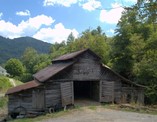
9840 Big Pine Road
Marshall, NC 28753
The Claude and Katie Wild barn is one of six distinctive monitor roof barns found only in the Walnut Township, with all but one in the Big Pine Creek valley. Being a unique and progressive barn design for 1918 in Madison County, it is speculated that the design, like the George Washington Wild barn, was built from a set of plans acquired in Tennessee by Claude Wild during his travels as a peddler. Read More
Fidel Baker Barn MDw0002

1355 Barnard Road
Marshall, NC 28753
Fidel and Laura Baker began their family on upper Big Pine Creek but later moved to the Walnut/ Barnard community where they completed their family of fourteen children. Also known as the Major Marler barn, and more recently owned by the late Bill “Bro Rat” Stanton, this barn is the only one of the unique monitor roof barns of this township that is outside of the Big Pine Creek valley, and is on the east side of the French Broad River. Read More
Harrison Roberts Barn MDw0003
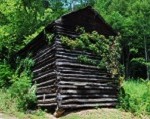
7596 Big Pine Road
Marshall, NC 28753
Researching the history of this large, log tobacco barn exemplifies the difficulty in dating and documenting these older barns. Oral tradition has this barn being built by Joe Worley prior to 1907 for landowner Harrison Roberts. That period predated the introduction of burley tobacco, indicating this barn was built for flue-cured tobacco, a conclusion supported by the spacing of tier poles at 24” to 30”, and the close spacing of the logs to accommodate mud chinking. Read More
John Baird McDevitt Barn MDw0004
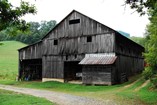
691 Upper Brush Creek Road
Marshall, NC 28753
Seen across the broad bottomland of Upper Brush Creek, the John Baird McDevitt barn is the largest, and one of the earliest barns in Madison County built for air-curing burley tobacco as its primary use. Prior to the 1930s, burley tobacco was cured in the lofts of livestock barns or in tall log barns that were adapted from flue-cured tobacco barn types. John Baird McDevitt, known as “Beard” to his friends, along with his brother Roy McDevitt, accumulated much of the land in the Upper Brush Creek valley. Read More
John Shelton Barn MDw0005

near 3900 Big Pine Road
Marshall, NC 28753
John Daniel Shelton, born July 1882, lived to be 99 years old. He spent much of his life in the Wilson Cove area of Big Pine where he built at least three other large log barns, on very steep land, which were likely flue-cured tobacco barns. According to family history, Shelton always built his barns and farmed “by the signs.” This barn is an exceptional example of a round log bank barn using a massive rock retaining wall, saddle notches and the old tradition of continuing the log wall into the gable end. Read More
Knox Brigman Barn MDw0006
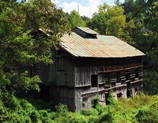
Ten Point Lane & US 25/70
Marshall, NC 28753
This barn is known to many local folks as the “Wall Drug” barn. For many years its roof was painted with a large “Wall Drug” advertisement sign, contracted by the Wall Drug Store in Wall, South Dakota, after a visit by Knox Brigman and his wife while part of a cross-country bus tour. By the 1980s the paint was beginning to flake, and since Mrs. Brigman wanted to replace her living room furniture, she negotiated with the Sterchi Furniture Company in Asheville to repaint the barn roof with a large “Sterchi’s” ad in exchange for a piece of furniture. Read More
Rubin Caldwell Barn MDw0007

8578 Big Pine Road
Marshall, NC 28753
The Rube Caldwell barn is one of the five distinctive monitor roof barns in the Big Pine Creek valley, with the signature diagonal lattice work and milled lapped board siding. Unlike the other monitor roof barns, however, this variation continued the tradition of using logs for the lower level for animal stalls, in four log cribs. Like the Claude Wild barn it is also a bank barn, providing drive-in access to the second level hay loft for unloading horse-drawn wagon loads of hay. Read More
Theodore Plemmons Barn MDw0008
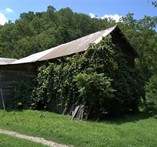
695 Sharp Hollow Road
Marshall, NC 28753
The Theodore Plemmons barn is a rare example of a log, flue-cured tobacco barn, and includes the old tradition of continuing the log end walls into the triangular gable area of the roof. This requires that the two gable ends be part of a roof structure of round pole “purlins” that span the distance between log walls, and lock the gable end logs in place. Remnants of the mud chinking used to fill the spaces between logs are still present, a surviving feature found in less than ten barns in Madison County. Read More
George Washington Wild Barn MDw0009
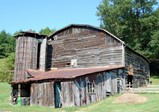
31 South Fork Road
Marshall, NC 28753
The George and Laura Wild barn and silo represent uncommon innovations of the late 19th and early 20th centuries. Born on Big Pine Creek in 1861, George Washington Wild later demonstrated the expert farming and business acumen of his father Jacob, operating a dairy and tobacco farm, a sawmill, grist mill, post office, blacksmith shop, and store. In 1919 Wild was elected to serve in the NC General Assembly, during which time he introduced a law to require fencing of livestock in order to end the tradition of livestock ranging free. Read More
Rubin Caldwell Flue-Cured Barn MDw0010
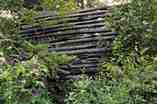
8578 Big Pine Road
Marshall, NC 28753
Rubin Caldwell, 1860 to 1962, built this barn prior to 1918 according to oral tradition provided by his son, McKindley Caldwell in 1985. It was the first flue-cured log tobacco barn documented in 1985 by this investigator as part of a historic house survey project. The original location was approximately 200 yards east of its current site, having been moved in 1918. McKindley Caldwell was proud to be able to describe the flue-cured tobacco process and barn features, knowing it was a century old barn type and tobacco variety that was all but forgotten. He described the rock furnace built inside on the dirt floor of the barn, configured in a “U” shape and sealed with clay mud.
Read More
